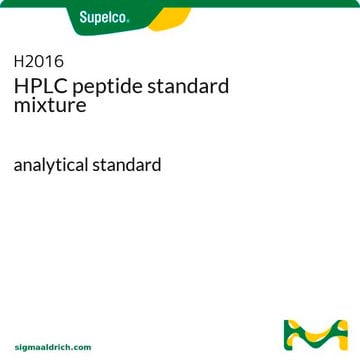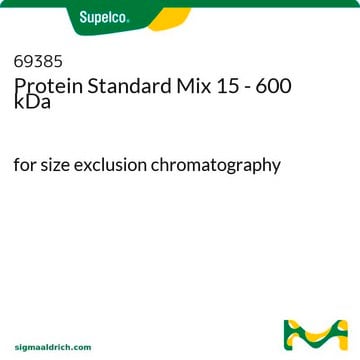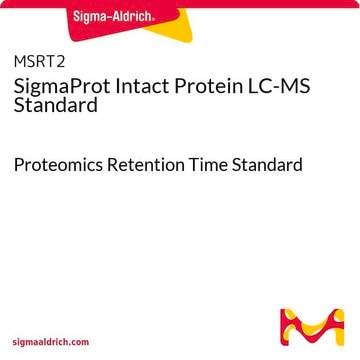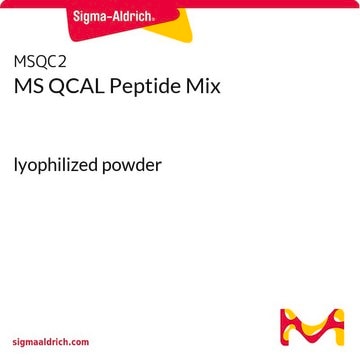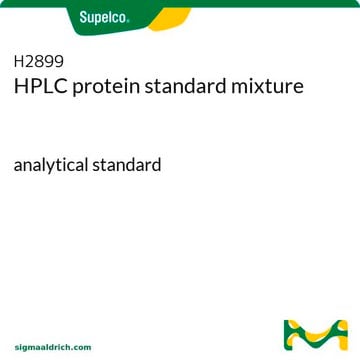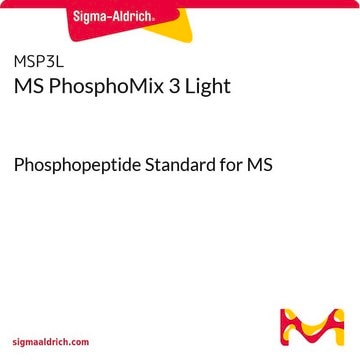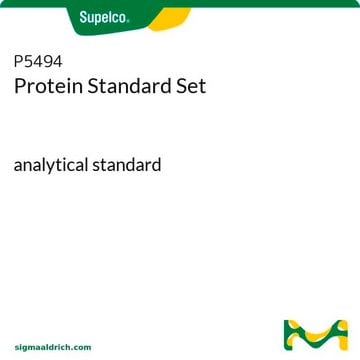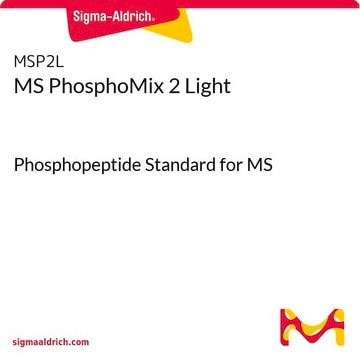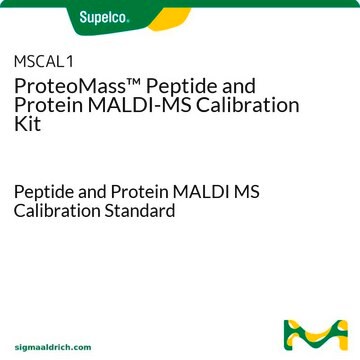MSRT1
MS RT Calibration Mix
Proteomics Retention Time Standard for LC-MS
Synonym(s):
Proteomics Retention Time Standard for LC-MS
Sign Into View Organizational & Contract Pricing
All Photos(1)
About This Item
UNSPSC Code:
12352200
NACRES:
NA.24
Recommended Products
form
ready-to-use solution
Quality Level
quality
Proteomics Retention Time Standard for LC-MS
analyte chemical class(es)
amino acids, peptides, proteins
technique(s)
HPLC: suitable
LC/MS: suitable
application(s)
food and beverages
format
multi-component solution
storage temp.
−20°C
General description
MSRT1 is an injection-ready standard, and can serve for quick tests of LC-MS platform performance, comparison of LC gradients and columns, monitoring column and system changes. MSRT1 can be used to predict retention times of peptides across LC-MS platforms. MSRT1 is also applicable to multiple reaction monitoring / selected reaction monitoring (MRM / SRM) analysis.
Components:
Each vial contains various amounts of 14 isotopically labeled synthetic peptides dried via vacuum centrifugation. Each peptide is labeled with either a [13C6,15N2] Lysine (+8 Da), a [13C6,15N4] Arginine (+10 Da), or a [13C6,15N] Leucine (+7 Da).
Components:
Each vial contains various amounts of 14 isotopically labeled synthetic peptides dried via vacuum centrifugation. Each peptide is labeled with either a [13C6,15N2] Lysine (+8 Da), a [13C6,15N4] Arginine (+10 Da), or a [13C6,15N] Leucine (+7 Da).
Application
MS RT Calibration Mix has been used as a reference for iRT (relative retention times) calculations after LC-MS (liquid chromatography–mass spectrometry)/MS analysis. It has been used to check the reliability and specificity of ETD-HCD (electron transfer dissociation-high-energy collisional dissociation) MS3 (mass spectrometry) method for leucine/isoleucine discrimination.
The MS RT Calibration Mix is a LC-MS platform standard intended to test properties such as LC resolution, peptide elution profiles, and retention time prediction. The peptides in MSRT1 are designed to span the normal elution profile of complex proteomic samples. The peptides have been added in various amounts, based on electrospray response, to have relatively similar response and be readily observed.
MSRT1 is an injection-ready standard, and can serve for quick tests of LC-MS platform performance, comparison of LC gradients and columns, monitoring column and system changes. MSRT1 can be used to predict retention times of peptides across LC-MS platforms. MSRT1 is also applicable to multiple reaction monitoring / selected reaction monitoring (MRM / SRM) analysis.
MSRT1 is an injection-ready standard, and can serve for quick tests of LC-MS platform performance, comparison of LC gradients and columns, monitoring column and system changes. MSRT1 can be used to predict retention times of peptides across LC-MS platforms. MSRT1 is also applicable to multiple reaction monitoring / selected reaction monitoring (MRM / SRM) analysis.
Features and Benefits
General
Complexity
Easily visualized
Injection-ready
Qualitative:
Quantitative:
MRM settings provided (Skyline, xls)
Complexity
- Defined mixture gives confidence in your instruments analysis
Easily visualized
- Distinct LC-MS peak profile of peptides, readily separated with similar responses
- iRT Table (xls)
Injection-ready
- Decreases prep time
Qualitative:
- Defined mixture of 14 stable isotope labeled (SIL) peptides
Quantitative:
MRM settings provided (Skyline, xls)
Legal Information
This product is licensed under U.S. Patent No. 7,396,688 and foreign counterparts from E. I. du Pont de Nemours and Company. The purchase of this product conveys to the buyer the nontransferable right to use the purchased amount of the product for research and development only, including services for a third party for consideration. The buyer cannot sell or otherwise transfer this product, its components or materials made using this product or its components to a third party. Information about licenses for excluded uses is available from: E. I. du Pont de Nemours and Company; Attn: Associate Director, Commercial Development; DuPont Experimental Station E268; 200 Powdermill Rd.; Wilmington, DE 19803; 1-877-881-9787 (voice), 1-302-695-1437 (fax), licensing@dupont.com.
analytical column
Product No.
Description
Pricing
Storage Class Code
11 - Combustible Solids
WGK
WGK 2
Flash Point(F)
Not applicable
Flash Point(C)
Not applicable
Certificates of Analysis (COA)
Search for Certificates of Analysis (COA) by entering the products Lot/Batch Number. Lot and Batch Numbers can be found on a product’s label following the words ‘Lot’ or ‘Batch’.
Already Own This Product?
Find documentation for the products that you have recently purchased in the Document Library.
Customers Also Viewed
A multicentric study to evaluate the use of relative retention times in targeted proteomics.
Vialas V, et al.
Journal of Proteomics, 152, 138-149 (2017)
Vital Vialas et al.
Journal of proteomics, 152, 138-149 (2016-12-19)
Despite the maturity reached by targeted proteomic strategies, reliable and standardized protocols are urgently needed to enhance reproducibility among different laboratories and analytical platforms, facilitating a more widespread use in biomedical research. To achieve this goal, the use of dimensionless
Distinguishing between Leucine and Isoleucine by Integrated LC-MS Analysis Using an Orbitrap Fusion Mass Spectrometer.
Xiao Y, et al.
Analytical Chemistry, 88, 10757-10766 (2016)
Yongsheng Xiao et al.
Analytical chemistry, 88(21), 10757-10766 (2016-11-02)
Despite the great success of mass spectrometry (MS) for de novo protein sequencing, Leu and Ile have been generally considered to be indistinguishable by MS because their molecular masses are exactly the same. Positioning of incorrect Leu/Ile residues in variable
Mohd Moin Khan et al.
Current research in immunology, 1, 10-22 (2021-04-06)
Cancerous inhibitor of protein phosphatase 2A (CIP2A) is involved in immune response, cancer progression, and Alzheimer's disease. However, an understanding of the mechanistic basis of its function in this wide spectrum of physiological and pathological processes is limited due to
Our team of scientists has experience in all areas of research including Life Science, Material Science, Chemical Synthesis, Chromatography, Analytical and many others.
Contact Technical Service